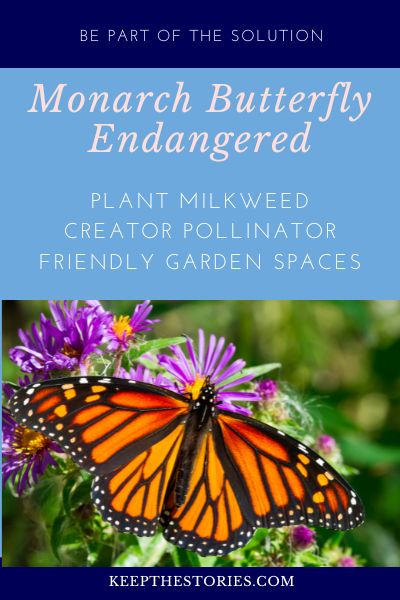Monarch Butterfly Endangered
Help Make a Difference
The migratory monarch butterfly (Danaus plexippus plexippus), known for its spectacular annual journey of up to 4,000 kilometres across the Americas, has entered the IUCN Red List of Threatened SpeciesTM as Endangered, threatened by habitat destruction and climate change.
Press release | 21 Jul, 2022
Migratory monarch butterfly now Endangered – IUCN Red List
Gland, Switzerland, 21 July 2022 (IUCN)
(globalnews.ca/news/9006683/monarch-butterflies-endangered-red-list/)
Monarch Butterfly On Threatened Species List
This week, the Monarch Butterfly, probably the most widely recognized butterfly, was officially identified as endangered. There are now more than 40,000 species on the threatened species list
Sadly, this does not come as a surprise. For years, we have heard much about increased threats to butterflies, bees and other pollinators. This decline is of particular concern because of the vital role that pollinators play in plant reproduction and, consequently, on our wildlife, plant diversity and food sustainability. Threats to pollinators come from many factors including climate change, invasive species, habitat loss, and pesticides compromising habitat and food sources. Butterflys often serve as the face of these dangers because they are loved by all. Monarchs in particular capture the imagination of many because of their unique long range migratory patterns.
Fortunately, there are things that we can do as individuals and communities.
Plant for Pollinators
Since 2018, I have been helping individuals and community organizations create pollinator-friendly garden spaces. For the last two years, I have been doing that as a volunteer with the David Suzuki Foundation Butterflyway Project (https://davidsuzuki.org/take-action/act-locally/butterflyway/), a volunteer-led initiative devoted to creating pollinator-friendly patches in gardens, balconies, schools and public spaces.
An excerpt from the butterflyway page:
Over the past five years, we’ve recruited and trained more than a thousand Butterflyway Rangers from hundreds of communities. They’ve connected with neighbours, schools, city agencies, businesses and community groups. To date, they’ve helped:
- Get 85,000+ butterfly-friendly wildflowers into the ground.
- Create 6,000+ pollinator patches for wild bees and butterflies.
- Establish official Butterflyways in 75 communities and neighbourhoods.
The Butterflyway Project shows that a small group of residents can make a big difference. Rangers make their communities greener and healthier. They create opportunities, connect people and champion fun ideas.
Ways You Can Help
Many bees and butterflies rely on specific plant hosts to survive, typically plants native to their habitat area. The link between monarch butterflies and milkweed is one of best-known examples of specific plant to pollinator relationships. Milkweed is the only plant here which Monarchs will lay eggs and the only reliable source of food for monarch caterpillars. Loss of milkweed on their migratory routes has put these popular butterflies on the endangered list. Some types of milkweed are considered invasive so people have been reluctant to plant it. However, not all milkweed falls into that category. For example, in Nova Scotia, swamp milkweed (Asclepias incarnata – L.) is native and will not take over your garden.
Tips for pollinator planting:
- Plant milkweed and other plants specific to pollinators in your area
- Convert lawns into natural habitat. According to the Nature Conservancy of Canada, if every home in the country replaced 1/4 lawn space with wild growth or natives, it would increase pollinator pathways by 14,000 hectares.
- Save and swap seeds and buy from local suppliers – it is the best way to have seeds that have grown well in your local area
- Grow native plants (find native nurseries at can-plant.ca/where-to-buy.htm)
- Use a variety of species that bloom from spring to fall
- Avoid pesticides and herbicides
- Connect with other individuals or organizations to create a butterfly way in your community – look for butterflyway rangers or join a local garden club
This is a way we can help to make a difference. While creating a welcoming natural space for people AND pollinators.
Do You Plant for Pollinators?
Do you have favourite pollinator plants?
What have you done differently to attractor more birds, bees, bats, butterflies – or other pollinators?
Please share any tips in the comments.



That would be terrible to lose the Monarchs! There was a special on TV today where the told what to plant and seems like some are planting the brightly colored milkweed which isn’t good. Lia and I love seeing the butterflies fluttering around her wildflower and butterfly gardens.
Some of my favorite native plants that attract pollinators are coneflowers, wild bergamont, phlox, black eyed susan, joe pye weed, and New England aster. They are colorful and beautiful and pollinators love them because they are native to my region (Western New York).
Sounds lovely. I’ve got all of those growing in my garden too except mainly Tiny aster rather than New England. All colourful, beautiful — and mostly perennial, which is nice too. Thanks for sharing.